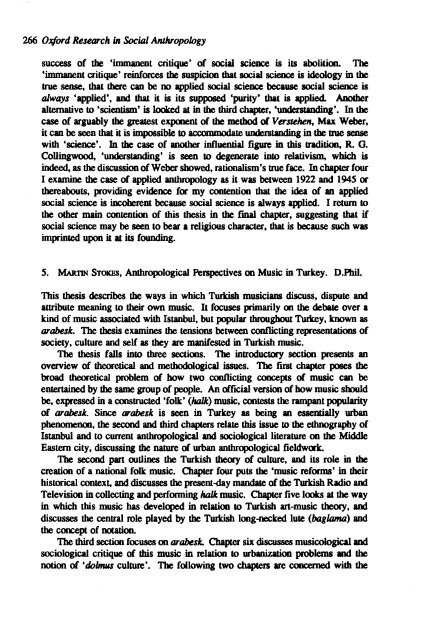1991 No. 1 CONTENTS - Institute of Social and Cultural ...
1991 No. 1 CONTENTS - Institute of Social and Cultural ...
1991 No. 1 CONTENTS - Institute of Social and Cultural ...
You also want an ePaper? Increase the reach of your titles
YUMPU automatically turns print PDFs into web optimized ePapers that Google loves.
266 Oxford ResetlTch in <strong>Social</strong> Anthropology<br />
success <strong>of</strong> the 'immanent critique' <strong>of</strong> social science is its abolition. The<br />
'immanent critique' reinforces the suspicion that social science is ideology in the<br />
true sense, that there can be DO applied social science because social science is<br />
always 'applied', <strong>and</strong> that it is its supposed 'purity' that is applied. Another<br />
alternative to 'scientism' is looked at in the third chapter, 'underst<strong>and</strong>ing'. In the<br />
case <strong>of</strong> arguably the greatest expooent <strong>of</strong> the method <strong>of</strong> Verstehen, Mu Weber,<br />
it can be seen that it is impossible to acrommodate underst<strong>and</strong>ing in the true sense<br />
with 'science'. In the case <strong>of</strong> another influential figure in this IJ'adition, R. o.<br />
Collingwood, 'underst<strong>and</strong>ing' is seen to degenerate into relativism, which is<br />
indeed, as the discussion <strong>of</strong> Weber showed, rationalism 'strue face. In chapter four<br />
I examine the case <strong>of</strong> applied anthropology as it was between 1922 <strong>and</strong> 1945 or<br />
thereabouts, providing evidence for my contention that the idea <strong>of</strong> an applied<br />
social science is incoherent because social science is always applied. I return to<br />
the other main contention <strong>of</strong> this thesis in the [mal chapter, suggesting that if<br />
social science may be seen to bear a religious character, that is because such was<br />
imprinted upon it at its founding.<br />
5. MARTIN STOICBS, Anthropological Perspectives on Music in Turkey. D.PhiI.<br />
This thesis describes the ways in which Turkish musicians discuss, dispute <strong>and</strong><br />
aWibute meaning to their own music. It focuses primarily 011 the debate over a<br />
kind <strong>of</strong> music associated with Istanbul, but popular throughout Turkey, known as<br />
arabesk. The thesis examines the tensions between conflicting representations <strong>of</strong><br />
society, culture <strong>and</strong> self as they are manifested in Turkish music.<br />
The thesis falls into three sections. The introductory section presents an<br />
overview <strong>of</strong> theoretical <strong>and</strong> methodological issues. The first chapter poses the<br />
broad theoretical problem <strong>of</strong> how two conflicting concepts <strong>of</strong> music can be<br />
entertained by the same group <strong>of</strong> people. An <strong>of</strong>ficial version <strong>of</strong> how music sbould<br />
be, expressed in a constructed 'folk' (balk) music, contests the rampant popularity<br />
<strong>of</strong> arabesk. Since arabesk is seen in Turkey as being an essentially urban<br />
phenomenon, the second <strong>and</strong> third chapters relate this issue to the ethnography <strong>of</strong><br />
Istanbul <strong>and</strong> to current anthropological <strong>and</strong> sociological literature on the Middle<br />
Eastern city, discussing the nature <strong>of</strong> urban anthropological fieldwork.<br />
The second part outlines the Turkish theory <strong>of</strong> culture, <strong>and</strong> its role in the<br />
creation <strong>of</strong> a national folk music. Chapter four puts the 'music reforms' in their<br />
historical context, <strong>and</strong> discusses the present-day m<strong>and</strong>ate <strong>of</strong> the Turkish Radio <strong>and</strong><br />
Television in collecting <strong>and</strong> performing ha/J; music. Chapter five looks at the way<br />
in which this music has devel~ in relation to Turkish art-music theory, <strong>and</strong><br />
discusses the central role played by the Twtish long-necked lute (baglmna) <strong>and</strong><br />
the concept <strong>of</strong> notation.<br />
The third section focuses on arabesk. Chapter six discusses musicological <strong>and</strong><br />
sociological critique <strong>of</strong> this music in relation to urbanization problems <strong>and</strong> the<br />
notion <strong>of</strong> 'dolmlu culture'. The following two chapters are concerned with the
















